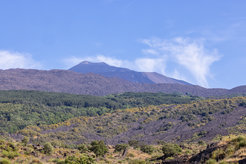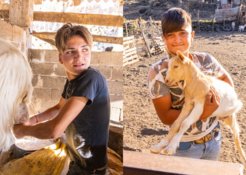Give animals a voice
A picture book, based on the science of animal disaster forecasting, inspires children to listen to animals
In an illustrated book for kids aged 4-8, ICARUS project coordinator Uschi Müller captures research into the sixth sense of animals. Salvatore and the Goats of Mount Etna, published by Greystone Books, is the first in a series about the hidden knowledge of animals and why we must find our way back to listening.

Deep under the eastern coast of Sicily, two tectonic plates meet. The plate that holds the African continent dives beneath the Eurasian plate, sinking slowly but surely into the earth’s mantle. Rising above this collision zone, soaring three thousand meters into Sicily’s blue sky, is one of the world’s most active volcanos: Mount Etna.
Mount Etna is in an almost constant state of activity. Lava explodes from its summit, and from vents scattered along its flanks, flowing down towards the human settlements perched on its slopes. The medieval town of Randazzo sits closest to the summit, and like all of Etna’s settlements, the bond between village and volcano is strong. Randazzo’s foundations rest atop old lava flows and its buildings are constructed from Etna’s basaltic rocks. The fertile soils produced from volcanic activity nourish orchards, vineyards, and grazing pastures.
It's these gifts that have lured farmers, like the Rosta family, to cultivate life at the foot of Etna. For generations, the Rostas have been farming the volcanic fields just outside the city of Randazzo. Today the family’s descendants, brothers Benito and Giuseppe, raise a large herd of sheep and goats. Every morning after milking, the family’s dogs help to herd the animals up the slopes of Etna to graze. The sheep stay on the lower slopes, whereas the goats run far up the mountain, some as high as 2500 meters, to find the best herbs, water, and salt.

And above the day-to-day business of running a farm, the ever-present threat of the volcano looms. The view from the Rosta’s farm includes remnants of destroyed huts and lava flows from recent eruptions. Yet life on Etna persists thanks to the knowledge of farming families that has accumulated over generations; knowledge that includes an ancestral collaboration between humans and the livestock that sustain them.
That’s why one spring day in 2011, when a pair of visitors turned up with an idea for how humans could learn from animals, Benito and Giuseppe were not particularly surprised. The visitors were Uschi Müller and Martin Wikelski from the Max Planck Institute of Animal Behavior in Germany. The pair were pursuing a project, known as ICARUS, with the grand goal of unlocking knowledge held by animals. By equipping a huge range of animals with trackers—akin to tiny mobile phones—scientists of the ICARUS project hope to listen to animals and to learn more about the planet in the process.
One of the things the scientists want to know is whether or not animals have knowledge of natural disasters before they become apparent to humans. Wikelski and Müller asked the Rostas if they thought livestock could sense when Etna was going to erupt. The brothers didn’t need to think hard. ”They absolutely agreed that farm animals could detect eruptions before humans,” said Müller, recalling the first meeting with the farmers. The brothers recounted to Müller, who speaks Italian, the stories that their parents had told about past disasters like the seven-day eruption of 1981 when lava threatened to destroy Randazzo. “Before these events, farmers noticed that goats would become very nervous, running down from the slope to seek shelter under the cover of trees,” Müller recalls being told.
The scientists presented the Rostas with an idea: why not give farm animals mobile phones? These tracking devices could continuously collect data about the animals’ behaviors, providing a way to “check in” with animals when eruptions occurred. “Benito and Giuseppe liked the idea of scientifically testing what they had observed in their animals,” says Müller. And the farmers knew precisely who to start with.

Helping Wikelski and Müller attach special collars on the farm’s goats, the Rostas became collaborators in the scientific project. “They checked our collars very carefully for quality and comfort to ensure goats would be safe at all times,” says Müller. The collars included sensors that collected GPS and movement data from animals continuously. With the first group of goats collared in 2011, the project has continued uninterrupted to this day. Wikelski and Müller have visited the Rosta farm every year to download data from the collars, save for a few years during COVID travel restrictions.
Almost 15 years into the project, the story that has emerged from the data is strikingly similar to that told by Benito and Giuseppe on that spring day in 2011. “From studying the goats’ movement patterns, we see that they become much more active before major volcanic eruptions,” says Müller. “Up to five hours before an eruption, goats run away from open pasture and into woodland.”
The findings on Etna are corroborated by another study conducted by Wikelski and Müller in an earthquake-prone region in central Italy. With the cooperation of another local farmer, the scientists tagged cows, sheep, farm dogs, chickens, turkeys, and one rabbit—all individuals chosen by the family as the animals most likely to pick up on imminent danger. Earthquakes hit the region in 2016 and 2017, and hours before both events, the activity of all the animals combined was about 50 percent higher than usual.
Taken together, the studies have quantified something of which we have long been aware but have up until now had no way to see in physical form: the “sixth sense” of animals. What could the animals tell us about our planet, and how we could use this information to benefit all species on earth? The answers to these questions are starting to come into view, and Müller wants to share the news.
“I want to convey the complex science as a simple story that could inspire future generations to think differently about animal intelligence, and better trust the animals in their own lives,” says Müller. Her book, Salvatore and the Goats of Mount Etna, published by Greystone Books, is the result. With beautiful illustrations by Brittany Lane, Müller transports readers to the foot of Etna and into the loving home of a family of goat herders. The book’s main character, Salvatore, bears the same name as the sons of Benito and Giuseppe Rosta.

The story starts one bright Sicilian day when Salvatore is given the job of herding the goats up the volcano. It’s his first time bearing this responsibility alone. With instructions from his papa that he must not let the goats boss him around, Salvatore is determined to do a good job and make sure they follow his command. But as he ascends the slope, something seems wrong. The goats become restless, and run away, which they have never done before. Salvatore is torn between following his father’s advice or his own instinct that the goats are telling him something important. Luckily Salvatore follows the goats down into a forest just in time before Etna erupts.
It's a parable for what Müller and Wikelski see as humanity’s urgent task: to find our way back to listening to animals, to valuing their knowledge, and to embracing them as partners. And the storytelling is set to continue. Müller has signed up with Greystone for a three-part series dedicated to more tales about the sixth sense of animals. Like the story of Salvatore, the series’ books will be rooted in scientific studies from the ICARUS project, with possibilities ranging from animals protecting animals on African reserves to the journey of cuckoos as they fly the longest migration of any land bird.
“I hope that this series will reach children, their parents, grandparents, relatives and friends,” says Müller, “and convince them why it is so important for humans to give animals a voice, and especially, to listen.”
Back on the island of Sicily, on a farm nestled at the foot of a volcano, there is one family that doesn’t need convincing. “The Rostas were not at all surprised by the results of the tracking study,” laughs Müller. “They’ve always believed that animals had something valuable to say. And they didn’t need the help of electronic transmitters to listen.”
Salvatore and the Goats of Mount Etna

By Uschi Müller
Illustrated by Brittany Lane
Published by Greystone Books
ISBN: 9781771649285
Uschi Müller is the coordinator of the ICARUS project (International Cooperation for Animal Research Using Space). Salvatore and the Goats of Mount Etna is her debut children’s book. She lives in Konstanz, Germany.
Brittany Lane is a wildlife biologist turned freelance illustrator and fine artist. After working as a wildlife biologist for a decade and working with a diverse range of incredible creatures, she turned to illustration to share her passion for nature and wildlife with others. She lives in Stouffville, Ontario.
















